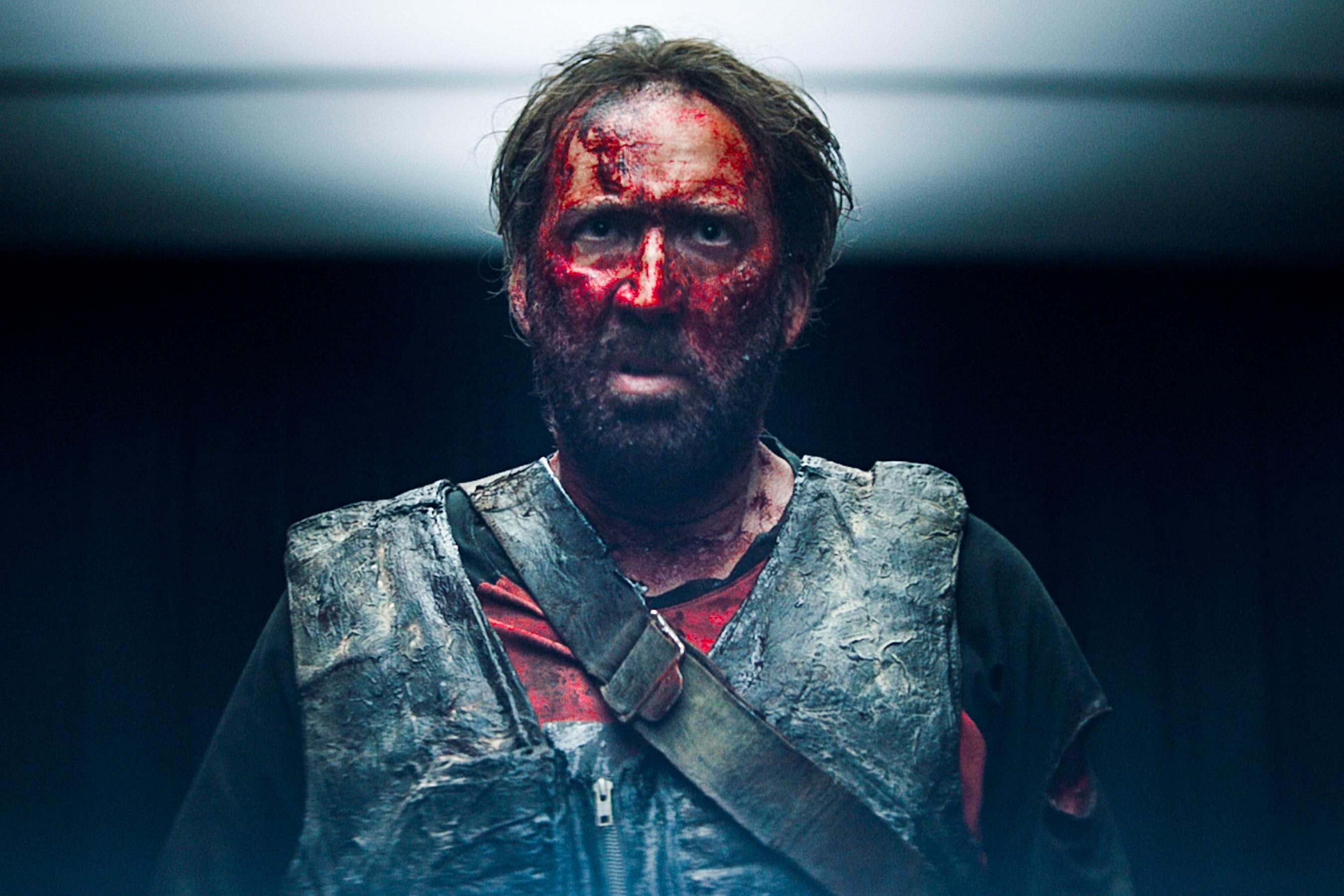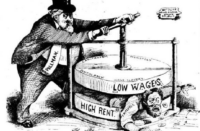Panos Cosmatos’s film Mandy (2018) has received widespread acclaim for its visually arresting murder-and-revenge story, set in a heavily aestheticised 1980s rural America (thanks to the cinematography of Benjamin Loeb). This article is not so much a review of the film as a critical assessment of some of the political implications of its narrative, and the role played by screen entertainment and the news media in the class struggle.
Mandy is notable for its repetition of a favourite trope of dominant film and television production, one that might be termed “backwoods evil.” The antagonists are (to borrow the language of cultural stereotyping) variously hillbillies, hicks, yokels, and a witch, all under the thrall of a cult leader, Jeremiah Sand, played by Linus Roache. He is a Charles Manson figure, whose lank hair, flowing robes and costume jewellery signify both a certain cheapness—a sort of “dime-store Jesus”—and the curdled promise of the (predominantly white apolitical) hippie movement.
He and his charges are unmistakably archetypes of the rural poor, and, crucially, they operate on the margins, if not the outside, of normal society.
The depiction of evil with a proletarian face is inextricably woven into the American cinematic and televisual imagination. It is the screen manifestation of a fundamentally bourgeois neurosis. This dual process is manifested most clearly in such films as Deliverance (John Boorman, 1972) and Blue Velvet (David Lynch, 1986). The protagonists in each, drawn as avatars of the white middle class, are hounded and beset by representatives of a rapacious and violent subaltern class.
The extent to which these films engage critically with their constituent iconography is a point for debate; what is incontrovertible is that each provides evidence that the dominant cinematic vocabulary of class hatred is readily available for directors to draw upon, as a painter to his palette.
Furthermore, it should be noted that these are all products of a culture that, in the most warped sense imaginable, dramatised its colonial genocide of the native population in the genre of the Western and the Manichean logic of “cowboys versus Indians.” In the cultural arm of the class struggle, the ruling class has always had a number of tools at their disposal, not least the aesthetic and mythical qualities offered by the medium of screen entertainment.
Prestige television products, such as “True Detective,” Season 1, promote a similarly malign logic. In it the vast conspiracy of child sex slavery and murder uncovered by its heroes finds its apogee in the Louisiana backwoods, its ultimate villain a schizophrenic ground-keeper who walks with a limp.
This is not to mention their weekly serialised equivalents—“CSI,” “Law and Order,” etc.—in which the violence and perfidiousness of the moneyed or political classes is studiously depicted as exceptional, while the degeneracy of the poor is beyond dispute.
More objectionable still is the dictate that the police and the military be portrayed always in favourable terms, with the occasional permissible exception of a “bad apple” or two, who serve only to illustrate by contrast the righteousness of their colleagues.
The active collaboration between film and television studios and the American military, police and intelligence services has been widely documented and criticised, and should give pause to those who might idealistically, or naïvely, expect any truly self-critical “messaging” to emerge from an industry so deeply compromised by imperialist and authoritarian interests.
The recent media attention paid to revelations of sexual abuse by wealthy and powerful men in Hollywood confirmed what was to many already widely known: that the entertainment industry as we know it is in part built on the back of the systematic sexual exploitation and silencing of women.
Appropriately, the detective stories produced within this culture, to an almost ritualistic degree, begin with a dead female body. In many cases, women in police shows are not there just to be killed but rather to already be dead. The woman as the victim of male violence, sexual assault or murder is the ground zero of narratives that then seek to depict the root of this evil as essentially proletarian in nature: maybe a black gang this week, or a janitor the next.
If these shows ever present the perpetrator as a man of power or influence it is with the commensurate fantasy that he faces justice of some kind in the end. They aim to obscure reality, rather than to reflect it honestly.
In Mandy, Cosmatos at least makes an attempt to humanise the victim of a ritual murder (played by Andrea Riseborough) before depicting the act itself. However, her character comes across as more of a loose collection of middle-aged men’s projections of flighty, mystical feminine beauty than as a real person. From the outset, what defines her and Nicolas Cage’s characters seems principally to be the consumption of pulp entertainment and minding their own business while living in a big log cabin in Reagan’s America. Of course she will soon be killed, and her husband will have the opportunity to avenge her.
The narrative of backward yokels forming the seat of American evil ties neatly in, of course, with the liberal version of the story of how Donald Trump became president, now repeated ad nauseam, to a point where it has become the mental wallpaper of the average bourgeois. In this version of events the “white working class” voted for Trump’s hateful, racist politics and against the alternative programme represented by Hillary Clinton, laughably presented as “progressive.”
Of course we know that in fact it was white people in general who voted in overwhelming numbers for Trump, who benefited also from huge support among the bourgeoisie more generally. Furthermore, we understand the conflict between the Democratic and Republican Parties as one between competing interests of the imperialist ruling class, and not at all the simple Good v. Evil, progressive v. conservative, cosmopolitan v. hillbilly narrative so pervasive in the news and entertainment media. “The woman is dead, and it was the working class that killed her”—what nonsense!
It is clear that the function of the dominant media is to obscure the real class relations that shape our society, of the exploitation of workers by capitalists, with the aim of dividing the working class against each other. In our news media we can observe this in the relentless demonisation of striking workers, whether teachers, nurses, or bus and tram drivers, simply for trying to agitate for better pay and conditions. Workers are depicted as villains, enemies of wider society, simply for standing up for their own interests.
What the media so desperately try to obscure is that striking workers stand up for all our interests, and that a victory for them is a victory for all workers. But for the capitalists and their media apparatus the aim is always the same: “Divide and conquer.” Paul Schrader’s Blue Collar (1978), for example, illustrates this dynamic with devastating effect. It is this attempt at breaking working-class solidarity that we must identify when it is operating, and actively resist.
Entertainment media in Ireland are certainly no better. Examining the weekday programming of Virgin One and Two (formerly TV3 and 3e) gives a speculative glimpse at what a regular television schedule might look like under fascism. “Frontline Police,” “Can’t Pay? We’ll Take It Away!” and the execrable “Paul Connolly Investigates”—all stalwarts of the television listings—are nothing more than the awful background hum of capitalism’s war against the working class.
Ryan Tubridy recently interviewed the fascist politician Nigel Farage on the Late Late Show, while the Claire Byrne Show frequently gives a platform on the national broadcaster to the most appalling reactionaries. Recall the dismal spectacle of the anti-choice side of the referendum on repealing the Eighth Amendment, heckling and jeering their way through a televised debate to a point where it became almost totally unwatchable.
For the dominant media, this sort of thing is a desirable outcome. They peddle bigotry, misogyny and racism and refer to it as “controversy.”
The recent presidential election was contested by, among others, three parasite businessmen from the RTE show “Dragons’ Den.” Arguably the most abhorrent of these, Peter Casey, built his platform in part on sexism, by decrying feminist politics, by anti-Semitism, by alleging that Jewish people possess undue influence on world affairs, and finally by denying the special ethnic status of the Travelling community and repeatedly casting slurs on them on live broadcast.
On his show Pat Kenny then went on to reproduce a talking point that can charitably be described as racist, asking each of the presidential candidates whether they themselves would want to live next to Travellers.
Whose interests, then, do news and entertainment media serve, in this country and abroad? We observe the constant repetition of pro-capitalist narratives, reactionary aesthetics, racist and misogynistic views, imperialist lies, anti-worker propaganda; and we say that this apparatus serves the interests of the ruling class, now as it has done in the past.
It is crucial that we challenge the lies and fabrications the capitalists offer to explain the state of affairs in which we find ourselves today. It is imperative that we attest that, if such a thing as evil exists, it is found in the boardrooms, suites, Oval Offices and military headquarters of the imperialists, and not in the hearts of the workers they try so desperately to turn against one another.
We must disabuse ourselves of the idealistic notion that capitalist media can ever serve the interests of the working class but must uphold those very interests ourselves wherever and whenever possible.






